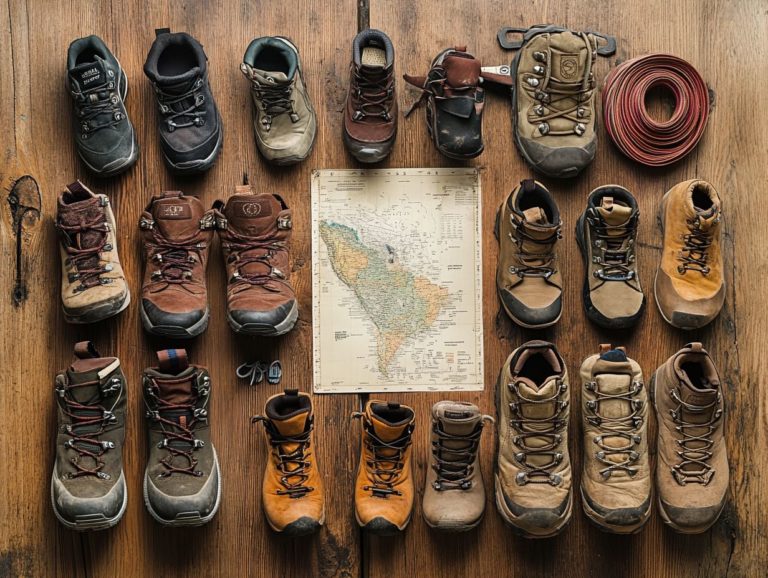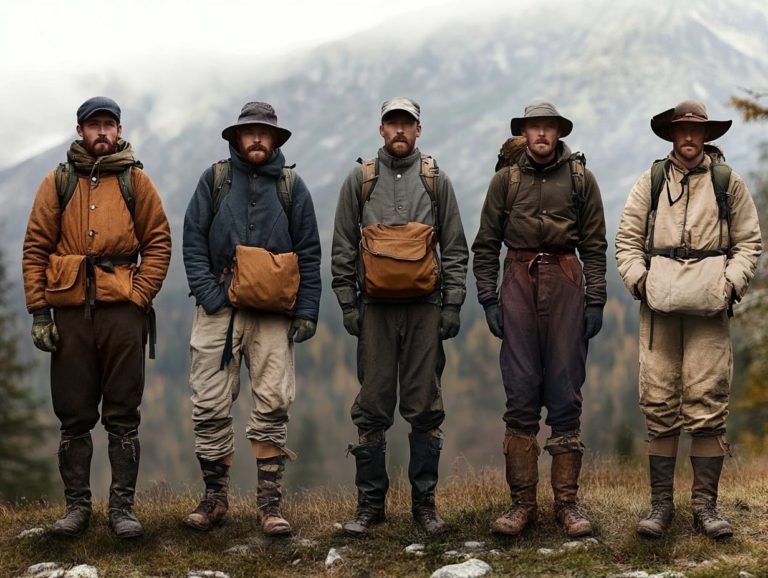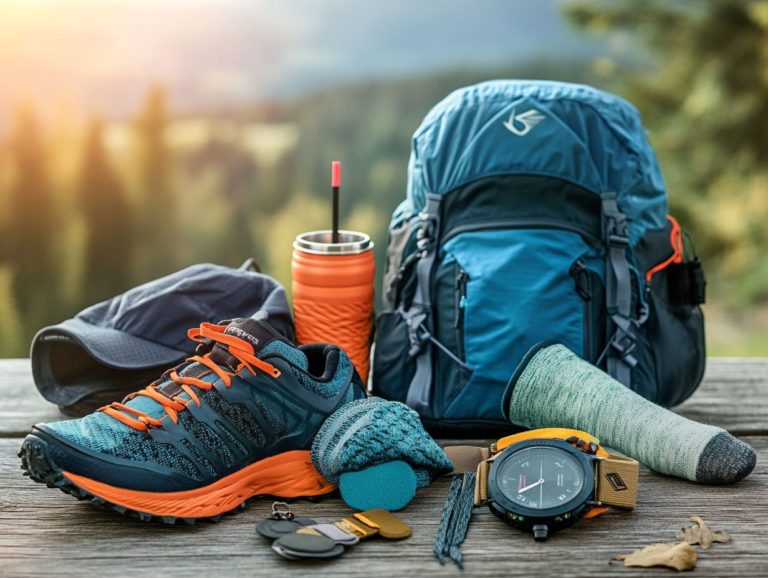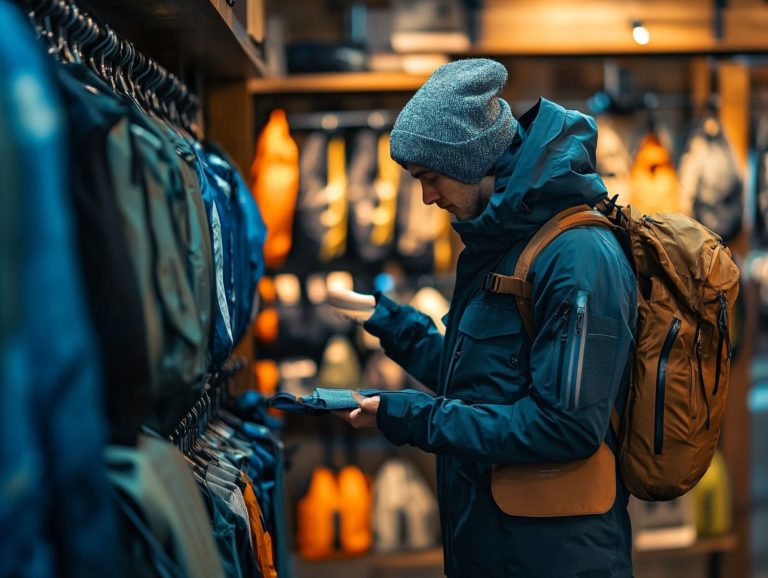The Role of Hydration Packs in Hiking
Staying hydrated can make or break your hiking adventure! Proper hydration is essential for any hiking trip, as dehydration can seriously affect both your performance and enjoyment on the trail. Engaging in outdoor activities like long-distance running highlights the importance of hydration.
This guide delves into the significance of hydration, specifically highlighting how hydration packs and hydration backpacks can elevate your hiking experience. You’ll explore the effects of dehydration and compare various pack designs, including options for bike rides and minimalist adventures. This empowers you to select the option that best suits your needs.
You will also find tips on proper use and maintenance, along with alternatives to ensure you remain refreshed throughout your journey.
Contents
- Key Takeaways:
- The Importance of Hydration in Hiking
- Benefits of Using a Hydration Pack
- Types of Hydration Packs
- Choosing the Right Hydration Pack
- Proper Use and Maintenance of Hydration Packs
- Alternatives to Hydration Packs
- Frequently Asked Questions about Hiking Hydration
- What is the role of hydration packs in hiking?
- Why are hydration packs better than water bottles for hiking hydration?
- How much water should I carry in my hydration pack for a day hike?
- Do hydration packs have any additional features besides carrying water?
- How do I properly clean and maintain my hydration pack?
- Can I use my hydration pack for other activities besides hiking?
Key Takeaways:
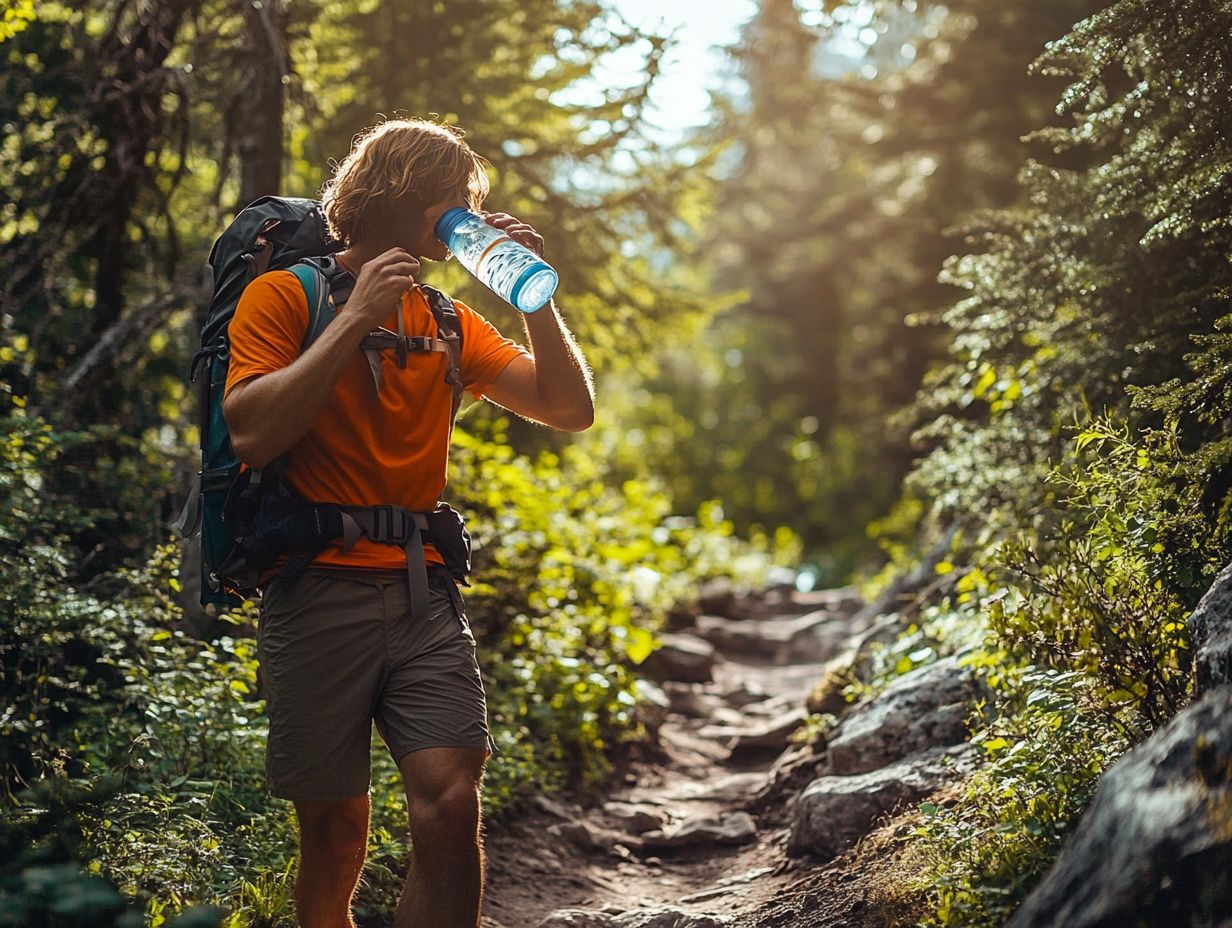
- Hydration is crucial for hiking performance. Dehydration can lead to fatigue, dizziness, and other health issues.
- Using a hydration pack offers convenience and efficiency on the trail, allowing for hands-free drinking.
- When choosing a hydration pack, consider size, capacity, fit, and features. Regular cleaning and replacing worn parts can prolong its lifespan.
The Importance of Hydration in Hiking
Hydration is vital for your hiking adventures, especially when engaging in outdoor activities like long-distance running. Staying well-hydrated can profoundly impact your performance and comfort.
Choosing the right hydration solution whether it’s a hydration pack or a hydration backpack ensures you have ample water while enjoying the experience without the burden of cumbersome gear.
For minimalist excursions, having a lightweight option and comfortable carry hydration system is essential, serving both casual day hikers and dedicated trekkers alike.
Effects of Dehydration on Hiking Performance
Dehydration can significantly impact your hiking performance, leading to fatigue, diminished concentration, and even serious health risks while you’re exploring the great outdoors, especially during outdoor pursuits.
When your body isn’t adequately hydrated, your physical endurance takes a hit, and your mental sharpness suffers considerably. You might find yourself grappling with decision-making and struggling to navigate trails. This can heighten the risk of accidents during your hike.
Use water packs or waist packs for quick hydration on the go. This allows you to sip consistently rather than waiting for scheduled breaks, thus maintaining your hydration levels throughout your experience. By adopting efficient drinking techniques like taking small sips frequently instead of gulping large amounts at once you can maintain optimal fluid levels. This proactive strategy keeps both your body and mind sharp, ultimately enhancing your overall hiking experience.
Benefits of Using a Hydration Pack
Opting for a hydration pack or hydration backpack offers numerous advantages. You ll enjoy generous water capacity and great storage, allowing you to stay well-hydrated during your adventures.
Plus, the on-the-go storage and organized compartments simplify your experience, giving you easy access to essentials. Best of all, it keeps your hands free for other tasks, enhancing your enjoyment while immersed in outdoor activities.
Convenience and Efficiency
Hydration packs are designed for your convenience and efficiency, often featuring a water pouch and a body-hugging shape that allows you to access water easily without interrupting your outdoor activities.
Their body-hugging shape and adjustable straps ensure a snug fit, minimizing movement and providing comfort even during intense workouts or long hikes. With innovative designs complemented by adjustable straps, these packs can be tailored to suit various body types, guaranteeing a secure fit.
Plus, the inclusion of zippered pockets enhances accessibility, enabling you to store essential items like snacks, keys, or tools without the hassle of digging through a larger backpack. This seamless blend of comfort and practicality transforms hydration packs into an invaluable companion for your adventures.
Types of Hydration Packs
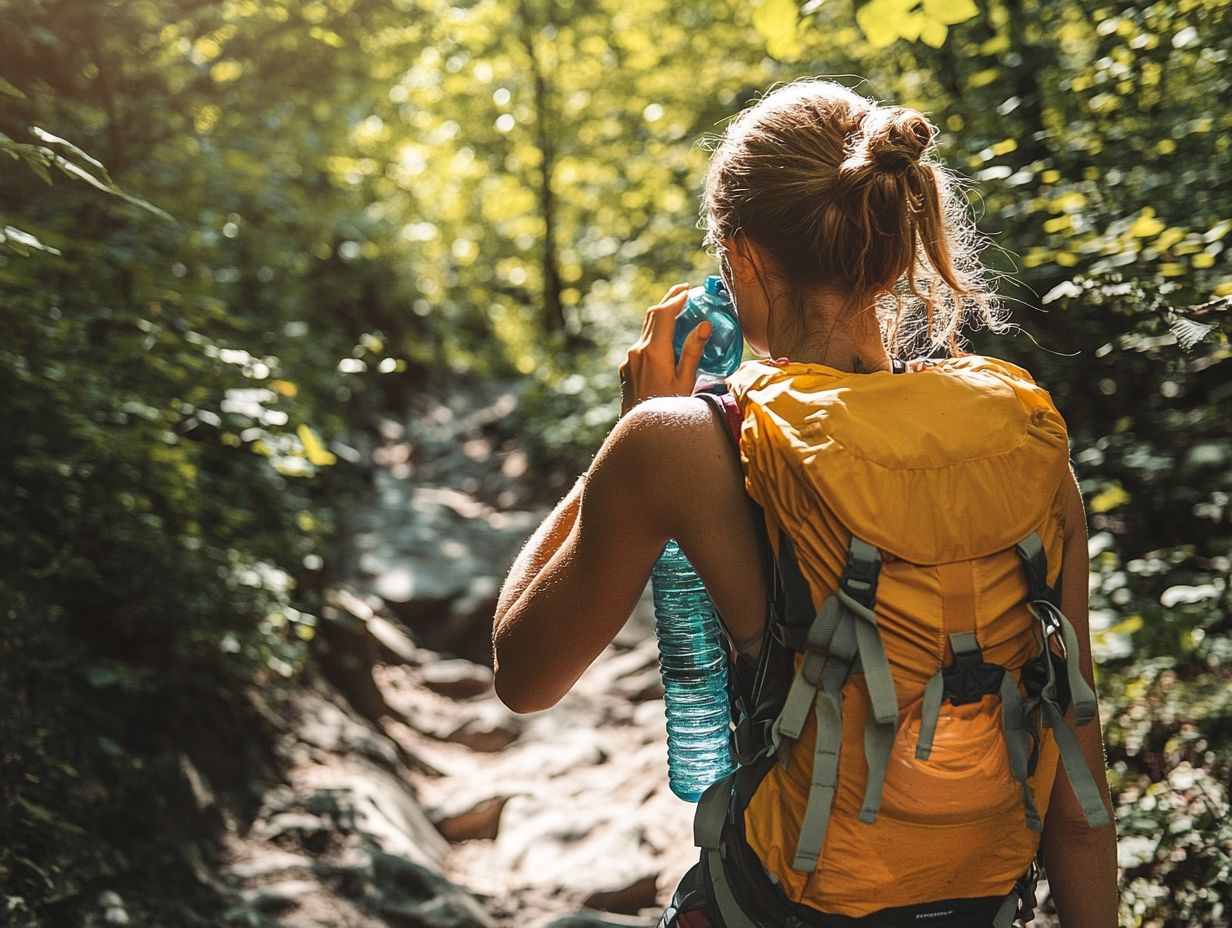
Discover a wide range of exciting hydration packs on the market, including the Gregory team and Osprey. These packs are carefully designed to cater to specific outdoor activities like hiking, biking, and minimalist adventures.
Comparing Different Designs and Features
When comparing designs and features of hydration packs, focus on aspects like quality construction, hiking-ready features, and innovative designs, such as bungee systems for added storage.
Brands like Gregory and Osprey truly stand out with their distinctive attributes.
Take Gregory’s Inertia 3D hydration pack, for example. It offers remarkable storage volume, allowing you to carry plenty without sacrificing comfort. The breathable back panel enhances ventilation during strenuous hikes, ensuring you stay cool even when temperatures rise.
On the flip side, Osprey’s Hydration Reservoirs shine with their intuitive design, making refilling and cleaning a breeze. Their Anti-Gravity technology provides a snug fit and supports optimal weight distribution, elevating your hiking experience.
By examining these features, it s clear how each brand, including Nathan and CamelBak, skillfully tailors its designs to meet the needs of different outdoor enthusiasts.
Choosing the Right Hydration Pack
Selecting the perfect hydration pack requires careful consideration of various factors, such as comfort, storage capacity, and the recommended retail price. Focusing on these elements ensures an exceptional experience during outdoor adventures.
Factors to Consider
When selecting a hydration pack, consider several important factors including comfort, storage volume, and adjustable straps for a personalized fit. Each of these elements is vital, especially during activities like hiking or biking.
Comfort is paramount; a well-fitted pack, like those from Thule or Deuter, can significantly enhance your experience, preventing chafing or discomfort during long treks.
Having adequate storage volume is essential for carrying all your necessary supplies be it snacks, extra layers, or tools for bike maintenance to ensure you remain well hydrated.
Adjustable straps not only provide a snug fit but also allow for customization of your pack’s position. This is crucial for maintaining balance on uneven trails or during those exhilarating, fast-paced rides.
Thoughtfully combining these factors sets the stage for a more enjoyable and successful outdoor adventure.
Proper Use and Maintenance of Hydration Packs
Proper use and maintenance of hydration packs are crucial for ensuring the quality of your hydration system. Taking these steps can maximize performance and extend the longevity of your hydration system during outdoor adventures.
Tips for Maximizing Performance and Longevity

To maximize the performance and longevity of your hydration pack, regularly clean it and store it properly when not in use. This helps prevent unnecessary wear and tear.
After each use, rinse the bladder and hose with warm, soapy water to ensure that any residual hydration doesn t spoil or encourage mold growth. Utilizing a specialized cleaning kit can help you reach those tricky spots that often go unnoticed.
Once your pack is completely dry, store it in a cool, dark place, away from direct sunlight. This will help maintain the integrity of the materials and seals. Remember to check the hydration system for leaks or signs of wear regularly. Addressing any issues early on can significantly enhance your pack’s lifespan.
Alternatives to Hydration Packs
While hydration packs have gained popularity for outdoor adventures, there are elegant alternatives for staying hydrated.
Consider traditional water bottles, hydration waist packs, or best hydration packs, all of which offer convenience and style while ensuring you remain refreshed on your journey.
Other Options for Staying Hydrated on the Trail
Stay refreshed and energized on your adventures! Explore various options for hydration on the trail, such as water bottles and hydration waist packs, each offering unique levels of efficiency and convenience.
Water bottles are typically easy to fill and carry but can quickly become hard to handle if they aren’t properly stowed, particularly during outdoor activities. While these bottles are often crafted from durable materials that can withstand rugged conditions, their size might hinder your movement.
Hydration waist packs, on the other hand, provide hands-free convenience and usually come equipped with water reservoirs (bladders that hold water), making them a low-profile solution that can carry enough water for your extended adventures. But they might not hold as much gear as larger backpacks.
For short hikes or bike rides, a simple water bottle works well. But for more rigorous trails or longer excursions, a hydration waist pack offers the ideal balance of hydration and mobility, ensuring you can focus on the trail ahead.
Frequently Asked Questions about Hiking Hydration
What is the role of hydration packs in hiking?
Hydration packs play an essential role in keeping hikers well hydrated on the trail by providing a convenient and hands-free way to carry water.
Why are hydration packs better than water bottles for hiking hydration?

Hydration packs are designed to fit snugly against your back, distributing weight evenly and reducing strain on your shoulders. This design allows you to drink water efficiently without stopping or taking off your comfortable backpack.
How much water should I carry in my hydration pack for a day hike?
It is recommended to carry 2-3 liters of water for a day hike, depending on the length and difficulty of the trail. Using hiking hydration packs ensures you stay hydrated, and it s always better to have more water than not enough.
Do hydration packs have any additional features besides carrying water?
Some hydration packs come with excellent storage options, including extra pockets and compartments for snacks, maps, and other essentials. They may also have a built-in rain cover to protect your pack and its contents in case of bad weather.
How do I properly clean and maintain my hydration pack?
To ensure the longevity of your hydration pack, clean it after each use by rinsing it with warm water and mild soap. Let it dry completely before storing. Regularly check for wear and tear to maintain your hydration system s quality and replace any damaged parts.
Can I use my hydration pack for other activities besides hiking?
Absolutely! Hydration packs are versatile and can be used for various outdoor activities such as long-distance running, cycling, and even skiing. They re also great for everyday use, making them perfect for casual day hikers, commuting, or traveling.
Stay prepared for your next adventure with the right hydration gear!

